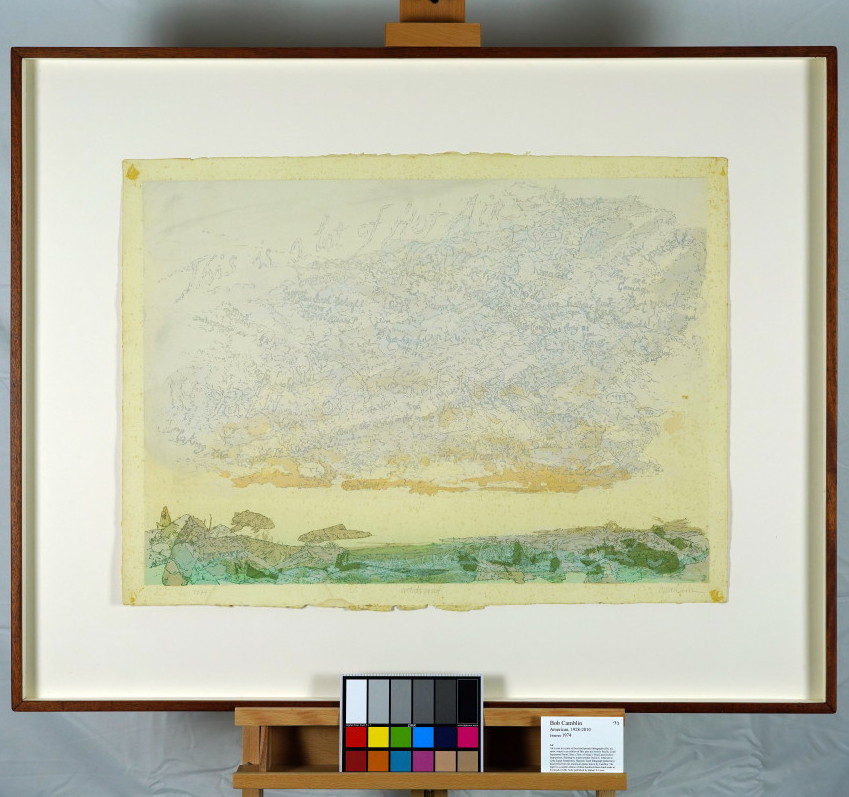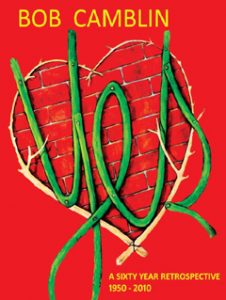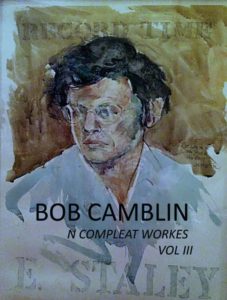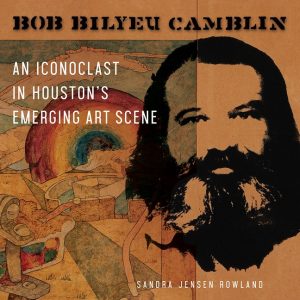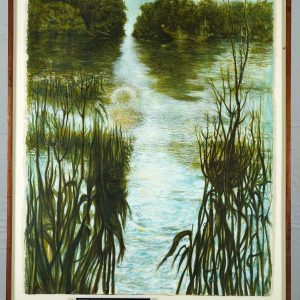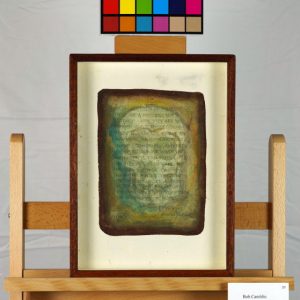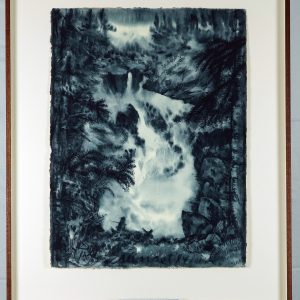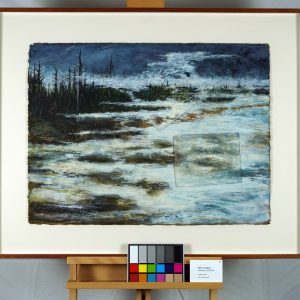Description
Air, 1974Lithograph on Twinrocker
Signed Artist’s Proof with two printer’s chops (what’s the reason for this?)
Part of The Elements suite
22 x 30in. (image)
32.5 x 40.5 in. (frame)
original, includes certificate of authenticity from ArtTrust
*Shipping cost will vary, please inquire at sales@camblingallery.com before purchasing.
Currently ships from Oregon, USA
Member of artnet? Apply for a discount! Inquire about intergallery and permanent loans for museums.
Air is one in a suite of four hand printed lithographs (the others in the series are earth, fire, water) in an edition of 50 plus 10 Artist’s Proofs, color separation proofs, a bon a tierer, a printer’s proof, and archive impressions. Printed by master printer Dave Folkman at Little Egypt Enterprises in Houston. Each lithograph is pulled on a hand press from 10 aluminum plates drawn by Camblin. The paper is a custom edition of 300 sheets hand made for this edition by Twinrocker Mill. Suite originally published by Robert S. Lowe.
The lithograph “Air” offers a visual meditation on the impermanence of thought and language. It was printed at Little Egypt Studios as a set and included “Fire”, “Earth”, and “Water”. At first glance, it presents a dreamlike landscape where fragments of text drift through the air, merging with the delicate hues of a fading sky. The ground below, consisting of rocky formations, appears solid and grounded, while the swirling mass of words floats above like a passing cloud, suggesting the ephemeral nature of ideas. The inscriptions seem to evoke a conversation with oneself or an unseen other, as if representing the echoes of inner dialogue or the impermanence of memory. The fading colors and indistinct lines hint at a sense of transience, challenging viewers to find coherence in an experience that resists definition.
In Zen philosophy, the notion of “emptiness” (Shunyata) is central, emphasizing that all phenomena are interconnected and lacking inherent permanence. The floating words in this image can be seen as a representation of this concept, suggesting that words and thoughts are momentary expressions of a much larger and ever-changing reality. The fragmented nature of the text encourages viewers to release the need for complete understanding and instead embrace the mystery and subtle beauty in the partial and incomplete. The horizon blends seamlessly with the sky, symbolizing the Zen ideal of non-duality, where boundaries between self and other, form and void, become meaningless.
Within the framework of the I Ching, the image resonates with the themes of Hexagram 59, “Dispersion” (Huan), which speaks to the dissolution of obstacles and the dispersal of rigid structures. The floating text illustrates the breaking apart of fixed meanings, allowing for a freer flow of insight and intuition. It symbolizes the dissolution of boundaries between consciousness and the natural world, encouraging a return to a more fluid and adaptable state of mind. The image of clouds merging with the earth suggests the harmony between Heaven and Earth, a core concept in I Ching philosophy.
The artwork serves as an invitation to contemplate the nature of perception, meaning, and existence. By uniting Zen’s emphasis on the transient and interconnected nature of reality with the I Ching’s concept of dissolution and renewal, the piece becomes a meditation on how meaning is both constructed and deconstructed. The ethereal words signify thoughts that come and go, while the landscape anchors the viewer to a physical reality that itself is ever-changing. This merging of the intangible with the tangible invites a deeper understanding of the cyclical nature of life and thought.
The work draws on elements of Romanticism and Symbolism, particularly in its approach to depicting the sublime and the ineffable. Like the works of J.M.W. Turner, the use of light and color creates a sense of boundlessness, while the faint text adds an element of mystery akin to Symbolist poets such as Stéphane Mallarmé, who explored the limitations of language in capturing experience. The suggestion of text as part of the landscape also evokes the calligraphy-infused art of East Asian traditions, where written characters are integral to the visual composition. This fusion of Western and Eastern influences underscores the universal quest for meaning amid the chaos of thought.
The piece leaves viewers with a paradox: while it presents elements that are solid and grounded, it simultaneously celebrates the fluid and fleeting nature of understanding, evoking a profound sense of introspective contemplation.
“Air” was featured in his Yes Retrospective, in volume III of the series Bob Camblin N Compleat Workes, and in Sandra Jensen Rowland’s monograph, Bob Bilyeu Camblin – An Iconoclast in Houston’s Emerging Art Scene.
Reproductions of this drawing are available in multiple sizes!
Click here to use our high-resolution viewer!
This artwork is available with a non-fungible token to ensure traceability and transparency of provenance.
The royalty factor – Unlike traditional artworks, such as paintings, mosaics, statues, and the like, NFTs can be programmed to provide royalties to you every time the painting (and token) is sold and resold – for eternity. That mind-bending Camblin you sold could be worth millions one day and provide income for your great-great-great grandkids!
Anti-forgery – The central idea underpinning NFTs is that they are built on the blockchain, which is meant to offer advanced security. Think of it like an un-erasable and un-avoidable copyright.
Easy authentication – Another compelling aspect of NFT art and NFTs in general is the ability to quickly and easily authenticate items, as the record of ownership is scrupulously kept on the blockchain.
